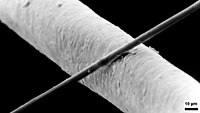
Photo from wikipedia
While various static cues such as matrix stiffness have been known to regulate stem cell differentiation, it is unclear whether or not dynamic cues such as degradation rate along with… Click to show full abstract
While various static cues such as matrix stiffness have been known to regulate stem cell differentiation, it is unclear whether or not dynamic cues such as degradation rate along with the change of material chemistry can influence cell behaviors beyond simple integration of static cues such as decreased matrix stiffness. The present research is aimed at examining effects of degradation rates on adhesion and differentiation of mesenchymal stem cells (MSCs) in vitro on well-defined synthetic hydrogel surfaces. Therefore, we synthesized macromers by extending both ends of poly(ethylene glycol) (PEG) with oligo(lactic acid) and then acryloyl, and the corresponding hydrogels that were obtained after photopolymerization of the macromers were biodegradable. Combining the unique techniques of block copolymer micelle nanolithography with transfer lithography, we prepared a nanoarray of cell-adhesive arginine-glycine-aspartate peptides on this nonfouling biodegradable hydrogel. The biodegradation is caused by hydrolysis of the ester bonds, and different degradation rates in the cell culture medium were achieved by different stages of accelerated pre-hydrolysis in an acidic medium. For the following cell culture and induction, both the matrix stiffness and degradation rate varied among the examined groups. While adipogenic differentiation of MSCs can be understood by the lowered stiffness, the osteogenic differentiation was contradictory with common sense because we found enhanced osteogenesis on soft hydrogels. Higher degradation rates were suggested to account for this interesting phenomenon in the sole osteogenic/adipogenic induction and even more complicated trends in the co-induction. Hence, the degradation rate is a dynamic cue influencing cell behaviors, which should be paid attention to for degradable biomaterials.
Journal Title: Biomaterials
Year Published: 2018
Link to full text (if available)
Share on Social Media: Sign Up to like & get
recommendations!